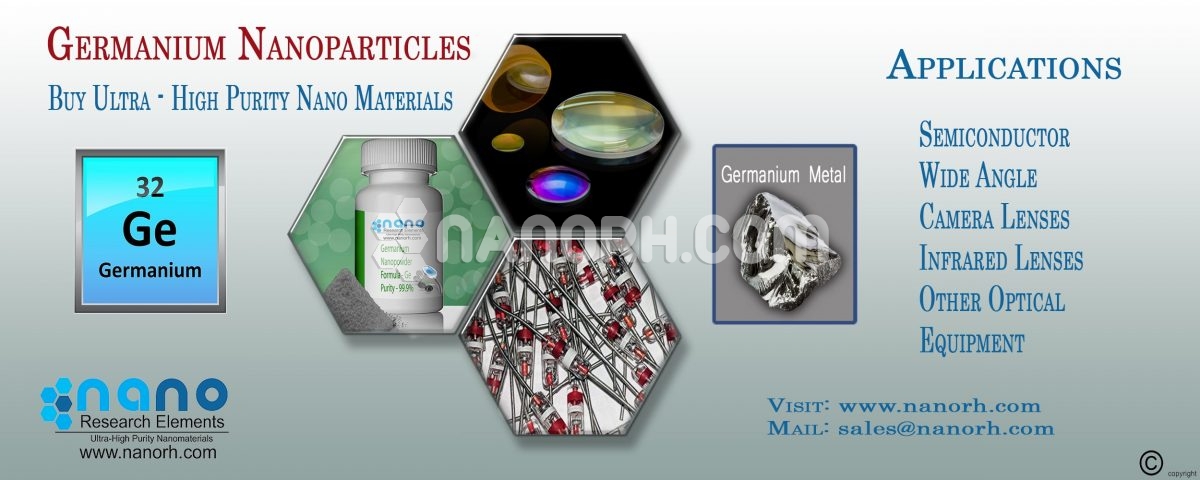Germanium Nanoparticles
GERMANIUM NANOPARTICLES
INTRODUCTION
Technically, germanium is classified as a metalloid or semi-metal. It is one of a group of elements that have properties of metals and non-metals. In its metallic form, germanium is silver, hard and brittle. The unique characteristics of germanium include its transparency to near-infrared electromagnetic radiation (at wavelengths between 1600-1800 nanometers), its high refractive index and its low optical dispersion. The metalloid is also intrinsically semiconductor.
The first commercial application for germanium came after the war, after the invention of the transistors by John Bardeen, Walter Brattain and William Shockley at the Bell Laboratories in December 1947. In the following years, transistors containing germanium found their way on the equipment Change of telephone,earphones, and portable radios.
Things began to change after 1954, however, when Gordon Teal of Texas Instruments invented a silicon transistor. Germanium transistors had a tendency to fail at high temperatures, a problem that could be solved with silicon. Until Teal, nobody had been able to produce silicon with a purity high enough to replace germanium, but from 1954, silicon began to replace germanium in electronic transistors and, in the mid-1960s, germanium transistors were practically non-existent.
GERMANIUM NANOPARTICLES
For more than a decade, elementary germanium nanoparticles have been of interest for a wide range of applications in areas including optoelectronics, bioimaging, energy conversion and storage. The small bandwidth gap of the mass germanium together with its wide Bohr radius (B24 nm) which makes the effects of quantum confinement on relatively large particle sizes and its favorable electronic properties observable makes germanium nanoparticles attractive to solar cells , field effect transistors, flash memory devices, photo detectors and labels for biological images at wavelengths transparent to the fabric. The germanium nanoparticles potentially offer less toxicity and a more environmentally friendly alternative to the narrow-band gaps II-VI, IV-VI and related III-V containing Pb, Cd or Hg.10 The capacity of colloidal germanium nanoparticles Dispersion in solution is also interesting for medical and biological applications, as well as for the processing of devices based on low-cost solutions. .
Over the past 25 years, the optical and electrical properties dependent on the size of the germanium nanoparticles have attracted extensive research on methods to control their size, shape, composition and surface chemical composition. Germanium nanoparticles is an interesting alternative for optoelectronic applications, as it combines a narrow band (0.67 eV) and high load-bearing mobility with a high absorption coefficient and an excitonic Bohr radius (24 nm). In addition to its compatibility with current microelectronic processing methods, germanium nanoparticles are also non-toxic, electrochemically stable and relatively inexpensive. However, most of the areas of application currently under consideration, including chemical detection, field effect transistors and photographic detectors, require the preparation of germanium nanoparticles with good performance with small size distributions and chemical chemistry. Well-defined surface, since these define many of his photographs. .
PHYSICAL PROPERTIES
Germanium Nanoparticles is mainly used as a semiconductor material for transistors. The first generation of semiconductors was based exclusively on germanium nanoparticles and therefore low-cost silicon was used. Subsequently, silicon-germanium alloys were developed. Thanks to its optical properties, germanium is used in optical fiber, infrared optics and solar cell applications.
GERMANIUM NANOPARTICLES FOR LITHIUM ION BATTERIES
In recent years, great attention has been paid to lithium ion (Li-ion) batteries due to their high power and power density in the most popular consumer devices, such as mobile phones, laptops and hybrid electric vehicles. The elements of the IVA group (such as C, Si, Ge and Sn) have been considered as promising materials for lithium ion batteries, in particular Silicon nanoparticles and Germanium nanoparticles, which have high theoretical capacities of 4200 and 1600 mA h g-1 respectively. Compared to Silicon nanoparticles, Germanium nanoparticles have a much lower theoretical capacity, but Germanium nanoparticles have a much higher lithium ion diffusivity (400 times higher than Silicon) and a higher electronic conductivity (104 times). higher than Silicon. This can be expected to provide better electrochemical performance. However, Germanium nanoparticles materials such as anodic materials for lithium ion batteries have poor cycle performance, which is similar to Silicon. The main reason is that there is still a drastic change in the volume of active material during the insertion process. Extraction of Li, which results in the pulverization of large particles. To solve the problem, special attention has recently been given to the preparation of Germanium nanoparticles, and it has been demonstrated that the synthesis of porous coating of Germanium nanoparticles and carbon effectively improves its electrochemical performance.

